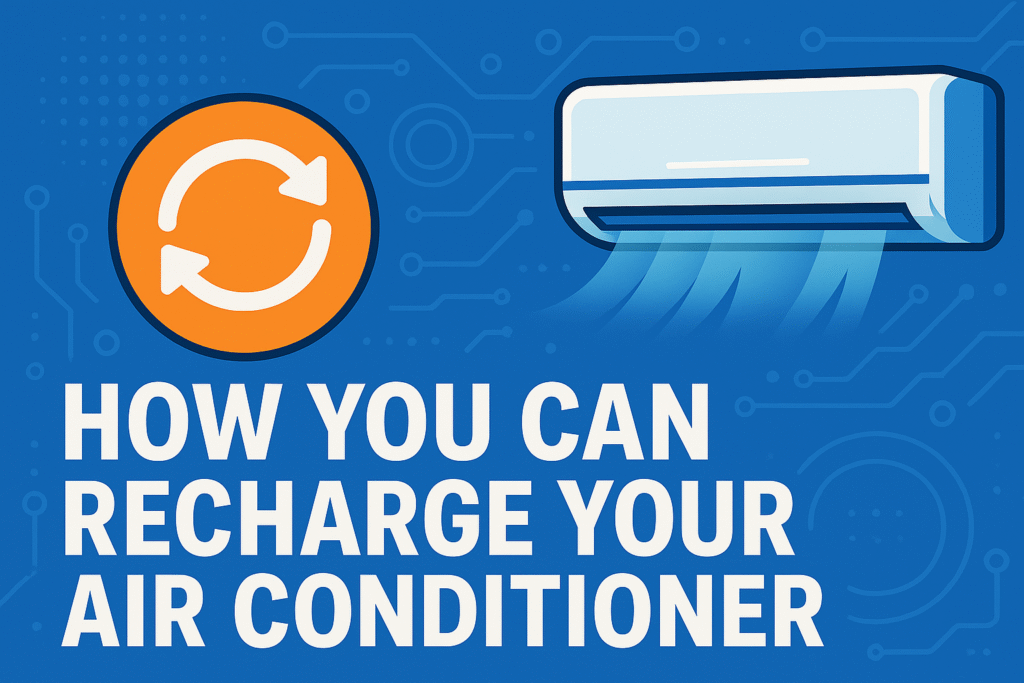As summer temperatures rise across Canada, a well-functioning air conditioner is essential to keep your home or business comfortable. However, over time, even the best air conditioning units can lose cooling power, often due to low refrigerant levels. That’s where the process of recharging your air conditioner comes into play. In this detailed guide, we’ll explore how you can recharge your air conditioner effectively, why it’s necessary, signs that indicate your AC needs a recharge, and why hiring professionals like GM HEATING AND COOLING INC is crucial for optimal results.
By understanding this process, you’ll ensure your AC unit runs efficiently, saves energy, and keeps your indoor environment comfortable all summer long.
What Is Air Conditioner Recharge, and Why Is It Important?
How you can recharge your air conditioner starts with knowing what AC recharge means. Recharging your air conditioner refers to the process of adding refrigerant, the cooling fluid that cycles through your system to absorb heat and release cool air. Over time, due to leaks or natural wear and tear, refrigerant levels can drop, resulting in reduced cooling capacity.
Without sufficient refrigerant, your air conditioner struggles to cool your space efficiently, causing longer running times and increased energy bills. Recharging restores refrigerant levels to manufacturer specifications, ensuring optimal performance and preventing damage to the compressor, a costly component to replace.
Signs You Need to Recharge Your Air Conditioner
Recognizing when and how you can recharge your air conditioner is necessary starts with identifying common warning signs. If your AC exhibits any of the following symptoms, it’s likely time for a recharge:
- Reduced Cooling Efficiency: The air coming from your vents isn’t as cold as it used to be, or your home takes longer to cool.
- Increased Energy Bills: A spike in your electricity bill without increased usage may indicate your AC is working harder due to low refrigerant.
- Ice Formation on Coils: Ice or frost buildup on evaporator coils is a tell-tale sign of low refrigerant.
- Hissing or Bubbling Sounds: These noises often indicate refrigerant leaks.
- Frequent Cycling: Your AC turns on and off more often than usual, which stresses the system.
- Warm Air from Vents: Instead of cool air, you may feel only warm or slightly cool air blowing.
If you notice any of these, it’s best to contact GM HEATING AND COOLING INC for an expert inspection and recharge service.
Can You Recharge Your Air Conditioner Yourself?
When considering how you can recharge your air conditioner, many homeowners wonder if it’s a DIY job. The answer is no—recharging an air conditioner is a complex, technical process requiring specialized tools and certifications. Improper handling of refrigerants can lead to environmental harm, personal injury, and damage to your AC unit.
Certified HVAC technicians at GM HEATING AND COOLING INC possess the skills to safely detect leaks, recover old refrigerant, and recharge your system with the precise amount of refrigerant required. They also ensure compliance with Canadian regulations on refrigerant handling, which is crucial for safety and environmental protection.
How Often Should You Recharge Your Air Conditioner?
There is no fixed timeline for how you can recharge your air conditioner, as frequency depends on several factors:
- System Age: Older AC units are more prone to leaks and may require recharging more often.
- Maintenance History: Regular maintenance reduces the likelihood of refrigerant loss.
- Leak Occurrence: Detecting and repairing leaks early can prevent frequent recharges.
- Usage Patterns: Heavy use during Canadian summers can stress the system, sometimes necessitating recharge.
Typically, a professional inspection and potential recharge are recommended at least once a year as part of routine AC maintenance. If your system shows performance issues, it’s best not to delay.
Types of Refrigerants Used in Canadian Air Conditioners
An essential aspect of how you can recharge your air conditioner is understanding the refrigerant type your system uses. Most modern Canadian AC units use R-410A refrigerant, known for its higher efficiency and lower environmental impact compared to older refrigerants like R-22 (also called Freon), which is being phased out due to ozone depletion concerns.
R-410A is a hydrofluorocarbon (HFC) that does not harm the ozone layer and offers better cooling performance. If your system uses R-22, it’s advisable to consider upgrading to a newer system or retrofitting to use environmentally friendly refrigerants.
Step-by-Step Guide: How You Can Recharge Your Air Conditioner
While DIY recharge is not recommended, knowing the professional process will help you understand the work GM HEATING AND COOLING INC performs:
- System Inspection: The technician checks for leaks, system damage, and refrigerant levels.
- Leak Repair: Any leaks must be fixed before recharging to avoid future refrigerant loss.
- Evacuation: Old or contaminated refrigerant is safely extracted using specialized recovery machines.
- Vacuuming: The system is evacuated to remove air, moisture, and contaminants.
- Recharging: The precise amount and type of refrigerant are added following the manufacturer’s specifications.
- Testing: The technician tests the system to ensure proper pressure, temperature, and cooling performance.
- Final Check: Seals are inspected, and the system is monitored to confirm leak-free operation.
Cost of Recharging an Air Conditioner in Canada
Understanding how you can recharge your air conditioner also means knowing the costs involved. In Canada, the average cost to recharge an air conditioner ranges between $200 to $400, depending on:
- Type and quantity of refrigerant required
- Need for leak detection and repairs
- Location and service provider fees
- AC system size and complexity
GM HEATING AND COOLING INC. offers competitive pricing and free consultations to provide accurate estimates tailored to your specific needs.
Environmental Considerations and Rebates in Canada
Canada places strong emphasis on environmental protection and energy efficiency. Using the right refrigerants and maintaining your AC system properly can reduce your carbon footprint and energy costs.
Some Canadian provinces offer rebates and incentives for upgrading to energy-efficient HVAC systems or for repairs that improve system efficiency, including refrigerant recharging with eco-friendly substances.
Ask GM HEATING AND COOLING INC about current rebate programs to maximize your savings while contributing to a greener Canada.
Why Choose GM HEATING AND COOLING INC for Your AC Recharge?
At GM HEATING AND COOLING INC, we pride ourselves on delivering expert HVAC services across Canada. Our certified technicians use the latest tools and follow strict safety and environmental protocols when performing air conditioner recharging.
Benefits of choosing us include:
- Accurate diagnosis and leak detection
- Use of approved refrigerants compliant with Canadian regulations
- Transparent pricing with no hidden fees
- Prompt, reliable service to keep your home cool and comfortable
Let us help you keep your air conditioner in top condition this summer and beyond.
Conclusion
Knowing how you can recharge your air conditioner is essential for any homeowner or business owner aiming to maintain efficient cooling during Canadian summers. Regular maintenance and timely recharging by professionals like GM HEATING AND COOLING INC not only restores comfort but also prolongs the life of your HVAC system and reduces energy costs.
If your air conditioner is showing signs of low refrigerant or reduced efficiency, don’t wait for the heat to become unbearable. Contact GM HEATING AND COOLING INC today to schedule a professional AC recharge and keep your space cool and energy-efficient.


